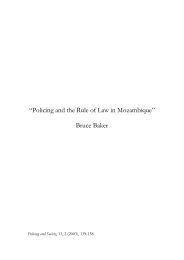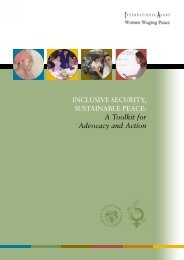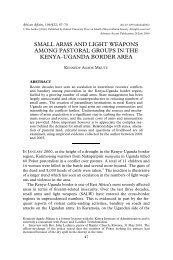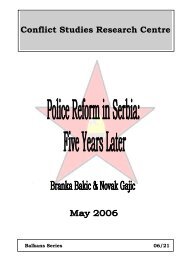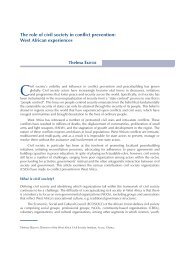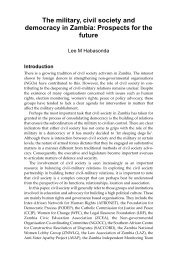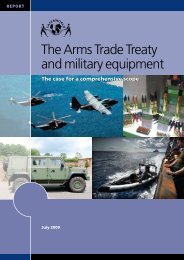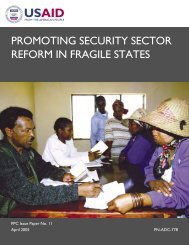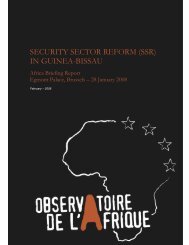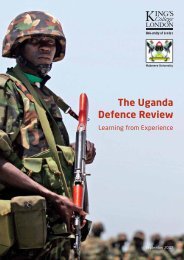AFGHANISTAN'S ELECTION CHALLENGES
AFGHANISTAN'S ELECTION CHALLENGES
AFGHANISTAN'S ELECTION CHALLENGES
You also want an ePaper? Increase the reach of your titles
YUMPU automatically turns print PDFs into web optimized ePapers that Google loves.
Afghanistan’s Election Challenges<br />
Crisis Group Asia Report N°171, 24 June 2009 Page 15<br />
exercises were abandoned in favour of yet another<br />
voter registry update at a cost of around $80 million. 112<br />
2. 242009 voter registry update<br />
The 2009 voter registry update was conducted in four<br />
stages countrywide 113 between October 2008 and<br />
February 2009. Another 4.4 million voter cards 114<br />
were issued to those supposedly not previously registered.<br />
In reality there was little, if any, protection<br />
against multiple registrations in this and the two previous<br />
exercises, with 17 million voter cards now in circulation.<br />
Given this, turnout should be measured in<br />
raw numbers rather than as a percentage of the inflated<br />
registry which could give an unfairly negative<br />
impression.<br />
The 2009 data, which ties new registrants to polling<br />
centres, has however been kept separate from that of<br />
previous rounds. It will be used in the future as the<br />
basis of a new registry with biometric information<br />
including fingerprints and photographs (although<br />
women were exempted) undergoing scanning in Kabul<br />
to detect multiple registrations. The outcome of this<br />
exercise depends on the quality of the data and honest,<br />
dependable staff. Multiple interviewees expressed<br />
misgivings, claiming that the fingerprints often appeared<br />
little more than purple smudges and that complicit<br />
election staff had overlooked individuals using different<br />
fingers to produce multiple cards.<br />
Lacking a census or basic population data, voter registration<br />
numbers are seen as a measure of a community’s<br />
strength, to be potentially flexed in elections. Noting<br />
that individuals and communities believe the cards have<br />
future bargaining value, an official from Kandahar said:<br />
“If they have registered they will be of importance to<br />
some political candidate; if not then no one will even<br />
bother to offer them a ride if they are standing by the<br />
side of the road. They are of no importance”. 115<br />
In some provinces, successive registration exercises<br />
saw so many cards distributed that the total is now<br />
greater than estimated population, underscoring the<br />
crucial need for basic population data and reliable<br />
national identity systems. Over the three exercises<br />
Nuristan has registered 443,000 voters 116 while the<br />
estimated population (including those too young to<br />
vote) is 130,000. 117 Similarly Panjshir has nearly<br />
190,000 registered voters while the entire population<br />
has been estimated at between 109,000 118 and<br />
137,000. 119 Such discrepancies could be the result of<br />
inaccurate population estimates or people registering<br />
multiple times over the years but not actually planning<br />
on using all their different cards on election day.<br />
However it increases the potential for fraud and highlights<br />
the difficulty of planning without reliable data.<br />
The scale of women’s registration should be of particular<br />
concern since some of the most insecure, and<br />
traditionally conservative, provinces have seen improbably<br />
high levels of female registration. In Logar,<br />
for instance, more than twice the number of voter cards<br />
were issued to women as men (36,000 women to<br />
14,000 men) in 2009, and the same was true of Nuristan<br />
(31,000 to 12,000). This is in stark contrast to far<br />
more liberal Kabul where the proportion of females<br />
registering in 2009 was less than half that of males<br />
(124,000 to 300,000). The practice, which may have<br />
started as “proxy voting” (men in traditional areas<br />
voting for the women in their family) has now expanded<br />
into large-scale fraud and is centred in the Pashtunmajority<br />
south east. In the 2009 exercise, the three<br />
south-eastern provinces of Paktia, Paktika and Khost<br />
saw 205,000 female registrations against 167,000<br />
males. In the neighbouring four southern provinces<br />
(Kandahar, Uruzgan, Zabul and Helmand), where<br />
many of the same cultural norms apply, there were<br />
196,000 women to 363,000 men.<br />
Registration in Paktika province, which reported that<br />
women had cast 47 per cent of votes in the 2004 presidential<br />
elections, reveals the extent of past fraudulent<br />
practices. This is a province where only sixteen girls<br />
attend primary school for every 100 boys (against a<br />
national average of 56), 120 and where the lack of female<br />
112 “The Situation in Afghanistan and its Implications for International<br />
Peace and Security”, op. cit., p. 3.<br />
113 Phase One: 6 October-4 November 2008 (fourteen provinces<br />
in the north, north east and centre); Phase Two: 5<br />
November-5 December 2008 (ten provinces mainly in the<br />
north and north west as well as Herat, Paktia and Kabul);<br />
Phase Three: 13 December 2008-13 January 2009 (six provinces<br />
in the south east and Farah in the west); Phase Four:<br />
20 January-19 February 2009 (four provinces in the south).<br />
114 “The Situation in Afghanistan and its Implications for<br />
International Peace and Security”, op. cit., p. 3.<br />
115 Crisis Group interview, Kandahar government official,<br />
Kabul, 16 March 2009.<br />
116 All voter registration figures used here are provided by<br />
IEC’s 2009 Voter Registration Data.<br />
117 The Central Statistics Office (CSO) “Estimated Population<br />
of Afghanistan 2008-2009”, puts Nuristan’s population at<br />
around 132,000 while preparatory work for the census also<br />
by the Central Statistics Office, “A Socio-Economic and<br />
Demographic Profile Household Listing 2003-2005”, puts<br />
it at 131,000.<br />
118 “A Socio-Economic and Demographic Profile Household<br />
Listing 2003-2005”, op. cit.<br />
119 “Estimated Population of Afghanistan 2008-2009”, op. cit.<br />
120 Afghanistan Human Development Report 2007, Center<br />
for Policy and Human Development, p. 164.




